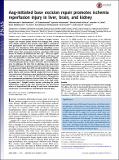| dc.contributor.author | Daneshmand, Ali | |
| dc.contributor.author | Mazumder, Aprotim | |
| dc.contributor.author | Allocca, Mariacarmela | |
| dc.contributor.author | Calvo, Jennifer A. | |
| dc.contributor.author | Abolhassani, Nona | |
| dc.contributor.author | Jhun, Iny | |
| dc.contributor.author | Muthupalani, Sureshkumar | |
| dc.contributor.author | Ayata, Cenk | |
| dc.contributor.author | Ebrahimkhani, Mohammad Reza | |
| dc.contributor.author | Samson, Leona D | |
| dc.date.accessioned | 2015-04-08T19:57:59Z | |
| dc.date.available | 2015-04-08T19:57:59Z | |
| dc.date.issued | 2014-10 | |
| dc.date.submitted | 2014-07 | |
| dc.identifier.issn | 0027-8424 | |
| dc.identifier.issn | 1091-6490 | |
| dc.identifier.uri | http://hdl.handle.net/1721.1/96476 | |
| dc.description.abstract | Inflammation is accompanied by the release of highly reactive oxygen and nitrogen species (RONS) that damage DNA, among other cellular molecules. Base excision repair (BER) is initiated by DNA glycosylases and is crucial in repairing RONS-induced DNA damage; the alkyladenine DNA glycosylase (Aag/Mpg) excises several DNA base lesions induced by the inflammation-associated RONS release that accompanies ischemia reperfusion (I/R). Using mouse I/R models we demonstrate that Aag[superscript −/−] mice are significantly protected against, rather than sensitized to, I/R injury, and that such protection is observed across three different organs. Following I/R in liver, kidney, and brain, Aag[superscript −/−] mice display decreased hepatocyte death, cerebral infarction, and renal injury relative to wild-type. We infer that in wild-type mice, Aag excises damaged DNA bases to generate potentially toxic abasic sites that in turn generate highly toxic DNA strand breaks that trigger poly(ADP-ribose) polymerase (Parp) hyperactivation, cellular bioenergetics failure, and necrosis; indeed, steady-state levels of abasic sites and nuclear PAR polymers were significantly more elevated in wild-type vs. Aag[superscript −/−] liver after I/R. This increase in PAR polymers was accompanied by depletion of intracellular NAD and ATP levels plus the translocation and extracellular release of the high-mobility group box 1 (Hmgb1) nuclear protein, activating the sterile inflammatory response. We thus demonstrate the detrimental effects of Aag-initiated BER during I/R and sterile inflammation, and present a novel target for controlling I/R-induced injury. | en_US |
| dc.description.sponsorship | National Institutes of Health (U.S.) (Grant R01-CA055042) | en_US |
| dc.description.sponsorship | National Institutes of Health (U.S.) (Grant R01-CA149261) | en_US |
| dc.description.sponsorship | National Institutes of Health (U.S.) (Grant P30-ES02109) | en_US |
| dc.description.sponsorship | Ellison Medical Foundation | en_US |
| dc.language.iso | en_US | |
| dc.publisher | National Academy of Sciences (U.S.) | en_US |
| dc.relation.isversionof | http://dx.doi.org/10.1073/pnas.1413582111 | en_US |
| dc.rights | Article is made available in accordance with the publisher's policy and may be subject to US copyright law. Please refer to the publisher's site for terms of use. | en_US |
| dc.source | National Academy of Sciences (U.S.) | en_US |
| dc.title | Aag-initiated base excision repair promotes ischemia reperfusion injury in liver, brain, and kidney | en_US |
| dc.type | Article | en_US |
| dc.identifier.citation | Ebrahimkhani, Mohammad R., Ali Daneshmand, Aprotim Mazumder, Mariacarmela Allocca, Jennifer A. Calvo, Nona Abolhassani, Iny Jhun, Sureshkumar Muthupalani, Cenk Ayata, and Leona D. Samson. “Aag-Initiated Base Excision Repair Promotes Ischemia Reperfusion Injury in Liver, Brain, and Kidney.” Proceedings of the National Academy of Sciences 111, no. 45 (October 27, 2014): E4878–E4886. | en_US |
| dc.contributor.department | Massachusetts Institute of Technology. Center for Environmental Health Sciences | en_US |
| dc.contributor.department | Massachusetts Institute of Technology. Department of Biological Engineering | en_US |
| dc.contributor.department | Massachusetts Institute of Technology. Department of Biology | en_US |
| dc.contributor.department | Massachusetts Institute of Technology. Division of Comparative Medicine | en_US |
| dc.contributor.department | Koch Institute for Integrative Cancer Research at MIT | en_US |
| dc.contributor.mitauthor | Ebrahimkhani, Mohammad Reza | en_US |
| dc.contributor.mitauthor | Mazumder, Aprotim | en_US |
| dc.contributor.mitauthor | Calvo, Jennifer A. | en_US |
| dc.contributor.mitauthor | Abolhassani, Nona | en_US |
| dc.contributor.mitauthor | Jhun, Iny | en_US |
| dc.contributor.mitauthor | Muthupalani, Sureshkumar | en_US |
| dc.contributor.mitauthor | Samson, Leona D. | en_US |
| dc.relation.journal | Proceedings of the National Academy of Sciences of the United States of America | en_US |
| dc.eprint.version | Final published version | en_US |
| dc.type.uri | http://purl.org/eprint/type/JournalArticle | en_US |
| eprint.status | http://purl.org/eprint/status/PeerReviewed | en_US |
| dspace.orderedauthors | Ebrahimkhani, Mohammad R.; Daneshmand, Ali; Mazumder, Aprotim; Allocca, Mariacarmela; Calvo, Jennifer A.; Abolhassani, Nona; Jhun, Iny; Muthupalani, Sureshkumar; Ayata, Cenk; Samson, Leona D. | en_US |
| dc.identifier.orcid | https://orcid.org/0000-0002-7112-1454 | |
| mit.license | PUBLISHER_POLICY | en_US |
| mit.metadata.status | Complete | |
